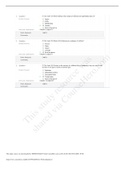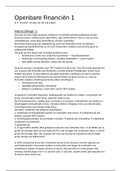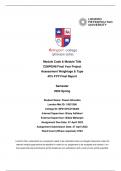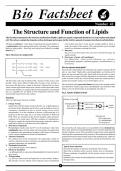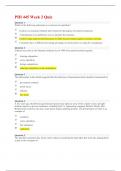Meeting 1.1 ............................................................................................................................................................................................................................................................................ 2
Study question 1 .............................................................................................................................................................................................................................................................. 2
Article 1: Thinking about strategy (Stoelhorst, 2008) ...................................................................................................................................................................................................... 2
Article 2: What in the world is competitive advantage? (Rumelt, 2003)......................................................................................................................................................................... 4
Article 3: Economics of strategy (Besanko et al., 2000)................................................................................................................................................................................................... 4
Article 4: A historical comparison of resource-based theory & five schools of thought within industrial economics (Conner, 1991) ............................................................................ 5
Meeting 1.2 ............................................................................................................................................................................................................................................................................ 7
Study question 2 .............................................................................................................................................................................................................................................................. 7
Article 5: Strategy and the business landscape (Ghemawat, 1999) ................................................................................................................................................................................ 7
Article 6: The structure within industries and companies’ performance (Porter, 1979) ................................................................................................................................................. 8
Meeting 2.1 ............................................................................................................................................................................................................................................................................ 9
Study question 3 .............................................................................................................................................................................................................................................................. 9
Article 7: The contributions of IO to strategic management (Porter, 1981) .................................................................................................................................................................... 9
Article 8: Towards a dynamic theory of strategy (Porter, 1991) ................................................................................................................................................................................... 10
Meeting 2.2 .......................................................................................................................................................................................................................................................................... 12
Study question 4 ............................................................................................................................................................................................................................................................ 12
Article 9: Firm resources and sustained competitive advantage (Barney, 1991) .......................................................................................................................................................... 12
Article 10: The cornerstone of competitive advantage: resource-based (Peteraf, 1993) .............................................................................................................................................. 13
Meeting 3.1 .......................................................................................................................................................................................................................................................................... 14
Study question 5 ............................................................................................................................................................................................................................................................ 14
Article 11: Value-based business strategy (Brandenburger & Stuart, 1996) ................................................................................................................................................................. 14
Article 12: Porter’s added value: high indeed! (Brandenburger, 2002) ......................................................................................................................................................................... 17
Meeting 3.2 .......................................................................................................................................................................................................................................................................... 17
Study question 6 ............................................................................................................................................................................................................................................................ 17
Article 13: Value capture theory: a strategic management review (Gans & Ryall, 2017) .............................................................................................................................................. 18
Meeting 4.1 .......................................................................................................................................................................................................................................................................... 20
Study question 7 ............................................................................................................................................................................................................................................................ 20
Article 14: The “Austrian” School of strategy (Jacobson, 1992) .................................................................................................................................................................................... 20
Article 15: Strategic factor markets: expectations, luck and business strategy (Barney, 1986) .................................................................................................................................... 21
Meeting 4.2 .......................................................................................................................................................................................................................................................................... 22
Study question 8 ............................................................................................................................................................................................................................................................ 22
Article 16: Asset stock accumulation and sustainability of competitive advantage (Dierickx & Cool, 1989) ................................................................................................................ 22
Article 17: Prospering in dynamically-competitive environments: organizational capabilities as knowledge integration (Grant, 1996) ..................................................................... 23
Extra article: Prahalad & Hamel .................................................................................................................................................................................................................................... 24
Meeting 5.1 .......................................................................................................................................................................................................................................................................... 25
Study question 9 ............................................................................................................................................................................................................................................................ 25
Article 18: Dynamic capabilities and strategic management (Teece et al, 1997) .......................................................................................................................................................... 25
Article 19: An evolutionary resource-based theory of competitive advantage (Stoelhorst & Bridoux, 2015) .............................................................................................................. 26
Meeting 5.2 .......................................................................................................................................................................................................................................................................... 29
Study question 10 .......................................................................................................................................................................................................................................................... 29
Article 20: Profiting from technological innovation: implications for integration, collaboration, licensing and public policy (Teece, 1986) ................................................................ 29
Article 21: Competitive dynamics and the paradox of increasing returns (Stoelhorst, 2005) ....................................................................................................................................... 31
Meeting 6.1 .......................................................................................................................................................................................................................................................................... 32
Study question 11 .......................................................................................................................................................................................................................................................... 32
Article 22: Explaining the attacker’s advantage: technological paradigm, organizational dynamics and the value network (Christensen et al, 1995)................................................ 32
Article 23: Balancing resource-based competitive advantage over a technology lifecycle (Stoelhorst, 2004) .............................................................................................................. 33
Meeting 6.2 .......................................................................................................................................................................................................................................................................... 35
Study question 12 .......................................................................................................................................................................................................................................................... 35
Article 24: When competitive advantage doesn’t lead to performance: the resource-based view and stakeholder bargaining power (Coff, 1999) ................................................... 36
Article 25: Value, rent and profit: a stakeholder resource-based theory (Stoelhorst, 2015) ........................................................................................................................................ 37
,Meeting 1.1
Study question 1
How can the neoclassical theory of perfect competition inform theories of competitive advantage?
The market is not perfect, why? Because there are all kinds of economic forces that influence market interactions.
Perfect competition is hypothetically and used only to see what happens to the industry when one breaks down
an assumption. This means: how the market interacts when you change one economic force. The influences of
these forces on the market create insights in business strategy and therefore on how competitive advantage can
be defines and achieved in different market situations.
Article 1: Thinking about strategy (Stoelhorst, 2008)
Strategy bestaat uit proces (opstellen/formuleren), content (welke is de beste) en context (hoe worden ze
toegepast in verschillende omstandigheden/bedrijven).
Strategy proces wordt vaak vergeleken met het standard model of strategy: 1) analyse, 2) kiezen, 3)
implementatie. Dit model komt voort uit de design en planning school.
Strategie is vanaf de jaren 60 eigenlijk pas echt onderzocht en werd steeds op een andere manier benaderd
door de tijd heen. Deze benaderingen hebben geleid tot 4 prescriptive schools.
1960 – Design school – all about the unique design
Strategie als een conceptueel proces, waarvoor skills en gecontroleerde human thinking nodig is. De CEO is
hiervoor verantwoordelijk en de lagere managers implementeren. De strategie moet informeel, simpel en
specifiek (uniek) zijn. Het design proces is af als de strategie volledig geformuleerd is en klaar voor
implementatie. Er is een duidelijk onderscheid in formulering (thinking) en implementatie (acting).
• Onderbelicht hands-on learning, niet alle CEO’s hebben kennis van de weaknesses, strengths,
opportunities en treaths (SWOT).
• SWOT is niet algemeen bekend en ook niet context-specifiek.
• Scheiding tussen formulering en implementatie zorgt ervoor dat CEO en ondermanagers niet van elkaar
kunnen leren.
• Assumpties beperken om in complexe situaties te kunnen handelen.
1965 – Planning school – all about the process planning
Strategie als een formeel, uitgewerkt proces door middel van flowcharts, checklists, etc. Het gaat om
rationeel denken en werkt de algemene strategie stapsgewijs uit tot een specifiek plan. Hierbij ontstaat een
hiërarchie in budget, doelen, programma’s, plannen, controles, etc.
• Is niet flexibel genoeg en té gedetailleerd, waardoor de strategie niet meer een samenhangend plan is.
Deze schools waren populair rond 1970. Hier was het doel van strategy voornamelijk gebaseerd op
marketshare en cash flows (BCG-matrix, product-life cycle, etc.) van business units. Na planning school
werd industry steeds meer betrokken en onderzocht in industrial economics (IO). Hiervoor werd een
hypothetische economie bedacht om te kunnen begrijpen hoe de markt en industrie werkt.
Perfect competition: goal is economic and social welfare. The assumptions of perfect market competition
will maximize welfare and prevents behavior based on self-interest. Assumptions to achieve this:
- Large number: of suppliers & buyers. Suppliers are price takers and returns are decreasing.
- Homogeneity: demand is homogeneous because of standardized products & firms are identical.
- Mobility: resources are perfectly mobile which creates free entry & exit.
- Rationality: buyers & sellers have complete information and maximize their utilization & profit.
- Transaction costs: allocating efficiency means no opportunity costs, so transactions are costless
(enforces free entry & exit).
Kortom, als alles perfect is, is er geen verlies bij buyer of supplier maar een evenwichtige verdeling in sociale
welvaart. De firm werd gezien als “black box”, weinig interesse en kennis in de firms zelf omdat dat niet als
belangrijk werd gezien.
Op basis hiervan kwamen Antitrust legislations die competitie zo ging regelen dat de sociale welvaart
behouden werd. Er werd al snel duidelijk dat perfect competition niet mogelijk was; aantal suppliers is
beperkt en maakt het niet aantrekkelijk voor entry, waardoor er blijkbaar barriéres zijn die perfect
,competition en dus welvaart onderdrukken. Het doel van industry research was om government te
adviseren hoe deze barriéres konden worden verminderd via policies.
Mede door deze nieuwe inzichten in de economie kwam Porter met een andere kijk op strategy die niet ging
om cashflows, niet om perfect competition, maar om positioning en competitive advantage.
1980 – Positioning school – competitive advantage is all about the best positioning
Strategie wordt gebaseerd op de industry structure, firm’s
conduct/behavior en performance (SCP- paradigm).
Industry determines firm’s performance where individual
firms can do better than industry’s average. Om de industry
structure beter te begrijpen kwam porter met de 5 forces
gericht op managers (i.p.v. government). Hierbij ging het
niet om social welfare, maar om firm profit en bescherming
tegen competitie. “Rather than using the insights to derive
policies and reduce barriers to competition and make markets
more competitive, Porter used these insights to derive
strategies to increase the profitability of individual firms by
raising barriers to competition.” Door middel van de generic
strategies (cost leadership, differentiation, focus) hielp
Porter managers om de “conduct” beter te begrijpen.
Hiermee kon een bedrijf zich beter positioneren, waarin het meer beschermd was tegen de 5 forces dan
competitors. De uiteindelijke performance (SCP) uitte zich in hogere profitability (favorable position in
attractive industry).
• Content: Bij design school gaat het om een unique strategy formuleren (process) en hier gaat het om
een generic strategy kiezen/positioneren (content).
• Strategy as fit: doel van strategie is om optimale fit te vinden tussen firm en environment met meer
focus op externe omgeving dan op interne omgeving.
• Imperfect competition: wordt gezien als voordeel omdat het zorgt voor kansen waarbij je positioneert
waar minste barriéres zijn.
• Essence of strategy is analysis: identify attractive industries, favorable positions & generic strategy.
• Science-based: eerste school of thought die gebaseerd is op economische theorie. Hierdoor was er een
outside-in approach waarin men dacht dat environment bepalend is voor succes i.p.v. managerial
actions en operations.
1990 – Resource-based school – competitive advantage is all about the core competencies
Deze school kwam als reactie op positioning school, waarin het ontbrak aan internal analysis. Bij perfect
competition gaan ze ervan uit dat alle firms en products equal zijn en dat je alleen concurreert in prijs. In
deze school wordt erkend dat firms verschillen, waardoor ook performance verschilt. Daarom ligt hier de
focus niet op products maar resources.
• Core competencies: resources die waarde toevoegen, inimitable zijn en toegang geven tot meerdere
markten. Competitive advantage behaal je als ze valuable, rare, inimitable én non-substitutable zijn.
De competencies zijn dynamisch en moeten aangepast worden wanneer nodig.
• Firm as a tree: Prahalad & Hamel (1990) leggen de focus op de ontwikkeling van core competencies.
Core competencies zijn de wortels van de boom en de stam bestaat uit core-products , waardoor de
business units (takken) groeien waaruit het blad/vrucht uitbloeit tot het eindproduct. Het
onderling delen van core competencies en knowledge leidt tot het succes van SBU’s (synergies).
• Strategie als “stretch”: de firm anticipeert niet op externe omgeving (fit), maar externe omgeving
anticipeert op de firm (stretch). Dit is een inside-out approach.
• Essence of strategy: with clear strategic intent developing unique resource combinations to deploy
core competencies.
Echter, het is niet altijd duidelijk wat relevante resources zijn en manager’s capability to shape environment
is limited.
Als reactie op deze schools ontstond een 5e descriptive school die niet strategie voorschrijft maar omschrijft
als een soort guideline met ruimte voor speling en vrije interpretatie.
, 1980 – Process school – all about collective learning as the process
Strategie is niet alleen rationeel, er is een verschil in intended en realized strategy. De realiteit is te complex
om volgens een vast model te werk te gaan, waardoor een strategie niet formeel kan worden opgesteld en
uitgevoerd.
• Strategie wordt gezien als collective learning process, waarbij effectieve strategieën incrementally
worden ontwikkeld afgaande op kansen. Gebaseerd op het verleden kunnen betere beslissingen
worden gemaakt. Process comes before content.
• Thinking en acting zijn onafscheidelijk omdat ze elkaar wederzijds beïnvloeden in het proces.
• Logical incrementalism is een omschrijving van strategy process, waarbij managers bounded
rationality hebben (beperkte denken) en reality niet stuurbaar is aangezien het ook wordt
beïnvloed door onverwachtse factoren (politiek bijv.).
Article 2: What in the world is competitive advantage? (Rumelt, 2003)
Common theme of competitive advantage is value creation. It’s not about getting superior values, but it
should explain how to achieve it. But value to who and when?
- Value is created by favorable terms of trade in the market → sales > costs.
o Which costs? How are costs measured?
- Advantage is defined as “supra-normal returns”
o Who defines what “super” is? Relative to expectation of owners, economy or industry?
- Advantage as means of stock market increasing.
o If stock increases of defence economies as result of crisis. Does this signal value creation?
Competitive advantage (CA) is een ambigue term:
- Porter: CA means low costs, a differentiation advantage or a successful focus strategy; CA is
achieved when value for consumers exceeds costs of creating it.
- Peteraf: imperfectly mobile resources create CA which is seen as “sustained above normal returns”.
- Barney: CA is when actual value is higher than expected value by actions that create economic value
in which few competitors are engaged in similar actions.
- Ghemawat & Rivkin: CA is superior financial returns over the long run.
- Besanko et al: CA is when a firm earns a higher rate of profit than average within the market.
- Saloner et al: CA is when firms produce at higher customer value or at lower costs than competitors.
- John Kay: CA is when distinctive capabilities (rare and sustainable) are exploited.
- Dierickx & Cool: CA is not obtainable from freely tradeable assets.
- Brandenberger & Stuart: CA comes from a favorable asymmetry (game of playing it different).
Areas of confusion:
1) How is value conceptualized/ measured?
2) What is the meaning of rents?
3) How to appropriate use opportunity costs?
4) Is CA about winning or having enough resources to maintain a position?
Value should be resistant to re-capitalization and not be subject to factor-price fallacy (wrong pricing).
Article 3: Economics of strategy (Besanko et al., 2000)
Accounting costs zijn historical costs die traceerbaar zijn in accountancy. Economic costs zijn deze kosten
plus opportunity costs (= waarde die je misloopt door het niet kiezen van het beste alternatief). →
Economic cost of deploying resources is the value of the best forgone alternative use of those resources.
Theory of the firm
The main goal is to maximize profits and to achieve that, firms want to set the prices as high as possible.
However, the firm’s demand curve limits what the price can be.
Marginal revenues/costs is extra revenues/costs of production per increase of 1 unit.
To increase profit the firm must do the following:
- MR > MC → increase profit by selling more. How? Lower price.
- MR < MC → increase profit by selling less. How? Raise price.


